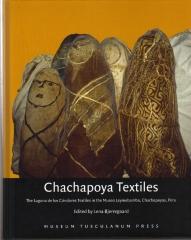In 1996 more than 200 mummies and skeletal remains accompanied by a rich array of burial offerings were discovered at a cliffside burial site overlooking Laguna de los Cóndores in the cloud forest of Chachapoyas. In spite of the humid climate in this remote corner of Peru's northeastern Andes, many of the organic remains, including textiles, were extraordinarily well preserved. The textiles are today stored or exhibited at the Museo Leymebamba.
The find includes the best preserved and largest cache of Chachapoya textiles known to date, providing researchers with a unique opportunity to learn about little-known Chachapoya weaving techniques, iconography, style, politics and trade connections. Most of the textiles date to the Chachapoya-Inka period, ca. 1470-1532, although some may have been produced earlier or may date to Spanish Colonial times. The styles include local Chachapoya, Chachapoya-Inka, provincial Inka, Inka and imports from the coast or the tropical lowlands.
In 2001 Lena Bjerregaard spent several months at the Museo Leymebamba studying the textiles from Laguna de los Condores, and this book analyzes 45 selected textiles, both burial offerings and mummy bundle wrappings. It also includes essays by other scholars on Chachapoya iconography, culture and khipus, as well as a description of the project launched to rescue the finds and the construction of the Museo Leymebamba.

(0 Comentarios)